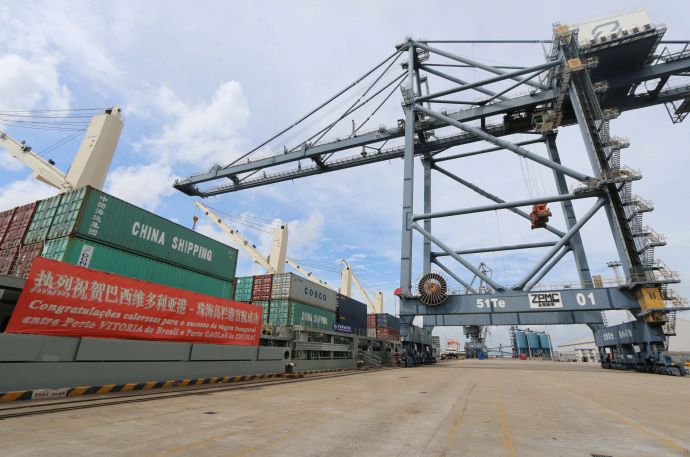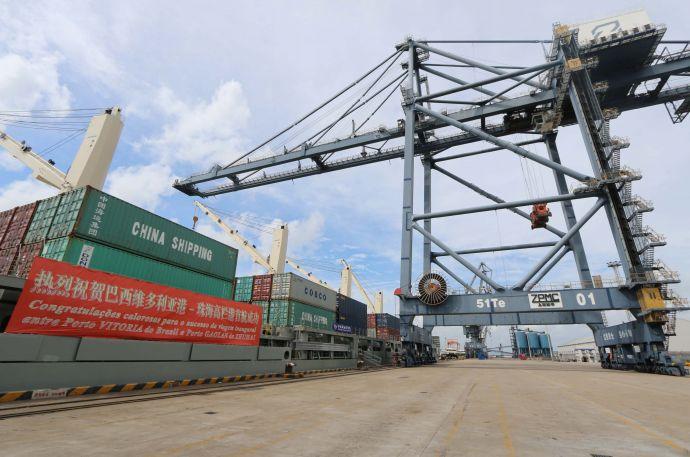
The first ship arriving at Gaolan Port after its inaugural voyage along the Victoria Harbor-Gaolan Route (Photo by Zhuhai Port Group)
BEIJING, Nov. 27 (Xinhua)--July 1, 2017 marked the opening of a direct sea route between China and Brazil when a cargo ship carrying 35,000 tons of granite and some other containers left Victoria Harbor for Zhuhai Gaolan Port.
After a 40-day-long journey, the cargo ship arrived at the Zhuhai Gaolan Port on August 10. Upon its arrival, officers of Gaolan Customs, subordinate to Gongbei Customs, boarded the ship for customs inspection and completed relevant procedures within half an hour.
The opening of this direct route provides a logistical foundation for cooperative projects of Sino-Brazilian cross-border e-commerce and aids trade integration. It also promotes Zhuhai as an important platform to expand the 21st Century Maritime Silk Road to Latin America.
In recent years, Zhuhai has been actively promoting the opening of direct routes between Zhuhai Port and countries along the Belt and Road, as well as those between Zhuhai and Latin American countries such as Brazil, to actively integrate Zhuhai into the Belt and Road Initiative. In this backdrop, Zhuhai Port Holdings Group Co., Ltd.(Zhuhai Port Group) has actively strengthened exchange and cooperation with Brazil’s Victoria Harbor.
Located merely 11 nautical miles from Daxi Waterway, Zhuhai Port is the only large-scale deep-water port in the west section of the Pearl River Delta and also serves as an important hub. Zhuhai Port Group acts as an important platform for expanding the opening up of Zhuhai. The group promotes Zhuhai’s modern logistics industry and capitalizes on its geographical advantages: proximity to Hong Kong and Macao the core of, Guangdong-Hong Kong-Macao Greater Bay Area and Xijiang River’s main outlet to the sea. It uses those advantages for vigorously deepening its participation in the Belt and Road Initiative.
So far, Zhuhai Port Group has opened 64 routes for container freightliners, of which 19 are international trade routes, primarily covering Japan, Vietnam, South Pacific, Taiwan, Hong Kong and Macao. From January to September 2017, Zhuhai Port Group’s cargo throughput hit 92,226,200 tons, a year-on-year growth of 42.31 percent, while its container throughput reached at 16,878,000 thousand TEU, a growth of 47.65 percent on year-on-a yearly basis.
Besides opening the direct route between Zhuhai Port and Brazil's Victoria Harbor, Zhuhai Port Group has also promoted the construction of a “Sichuan, Guizhou and Guangdong-South Asia Major International Logistics Passage”.
Sichuan, Guizhou and Guangdong-South Asia Major International Logistics Passage uses Zhuhai Port as the fulcrum to domestically connect Guangxi, Guizhou, Sichuan and Yunnan in southwest China through Xijiang River and railways. At the same time, it internationally connects ports in Southeast Asia and South Asia via sea routes.
Imagine that boxes of durian, mangosteen and dragon fruit are being efficiently dispatched from Laem Chabang Port in Thailand and expediently arriving at Zhuhai Gaolan Port in China via sea. After customs clearance, the fruits will reach Chinese customers via wholesale markets and supermarkets in a much shorter time span than before.
“Fruit transportation has a strict requirement of timeliness and thus demands highly efficient logistical services,” said Huang Xin, deputy general manager of Zhuhai International Container Terminals (Gaolan) Limited. “For example, after durians are picked from trees, it is best that they arrive at supermarkets within seven days. Any delay will mean cracking of the fruit, damaging its appearance and marketability.”
Thankfully, with the to-be-opened direct route between Laem Chabang Port and Zhuhai Gaolan Port – a section of the Sichuan, Guizhou and Guangdong-South Asia Major International Logistics Passage, it will save half a day or a whole day for fruit transportation from Thailand to China. Besides Thailand fruits, a larger number of marine and agricultural products from Southeast Asian countries will enter Chinese market. At the same time, Chinese household appliances and fruits from northern China will be easily exported to Southeast Asian countries, realizing complementary advantages through mutual exchange of products.
“Sichuan, Guizhou and Guangdong-South Asia Major International Logistics Passage will make Zhuhai a marine gateway in the Southwest region,” said Zhou Weibo, chief of Information and Logistics Department of Zhuhai Traffic and Transportation Bureau. “Moreover, Zhuhai Port will expand further to the great Southwest region and further to the Northwest, integrating into the Silk Road Economic Belt and connecting China-Pakistan Economic Corridor. In this way, Zhuhai Port will be shaped as one of the important fulcrums connecting the 21st Century Maritime Silk Road and the Silk Road Economic Belt.”
“The aim of these projects is not to build a couple of ports or to open a couple of routes, but to utilize cross-border resources to promote interactivity and complementary cooperation, thereby creating a synergy of ‘1+1>2’,” said ZhouWeibo.
The major passage will connect domestic and international markets and go through all major economic zones, effectively lowering logistics costs. At present, Sichuan, Guizhou, Guangdong and Southeast Asian countries are showing great zest for participation.
Elaborating this point with an example, Huang Xin said that as the largest container terminal enterprise under Zhuhai Port Group, Zhuhai International Container Terminals (Gaolan) Limited has been engaged in import business of fruits since August 1, 2017 following approval from General Administration of Quality Supervision, Inspection and Quarantine. Soon afterwards, Gaolan Port Economic Zone, Thaishun Group of Thailand and Zhuhai International Container Terminals (Gaolan) Limited started business negotiations and signed a three-party strategic cooperation agreement to promote the development of Zhuhai’s imported fruits, Huang added.
At Guizhou (Changming) International Inland Port, the fast-paced work tempo shows the motivation of all parties in building the major passage.
Guizhou (Changming) International Inland Port is situated at Qiannan Prefecture in Guizhou. It is an important logistics node on the Sichuan, Guizhou and Guangdong-South Asia Major International Logistics Passage. It is being jointly founded by Zhuhai Port Group and Guiding County Government of Qiannan Prefecture.
“Working overtime is a routine for both local government staff and the company employees. Everyone is filled with a high sense of responsibility and mission. Everyone is strongly motivated and looking forward to an early completion of the project,” said Xu Guofeng, general manager of Guizhou (Changming) International Inland Port Management Co., Ltd. “The aim of the project is to establish Guizhou (Changming) International Inland Port as an important logistics hub on the 21st Century Maritime Silk Road and a convenient passage to the sea in the great Southwest region, thereby providing a comprehensive cross-province and cross-country trade and commerce logistical services platform,” Xu said.
Just as farming in spring and harvesting in autumn, Zhuhai Port Group, strengthening connectivity with international passages these years, has provided strong seaway support for deepening Zhuhai’s cooperation with countries along the Belt and Road. It is foreseeable that with more and more projects coming to fruition, more foreign trade routes will be opened, breaking all geographic trade barriers. The world shall witness prosperity along those routes. (Reporter:Wang Huyun)




 A single purchase
A single purchase









